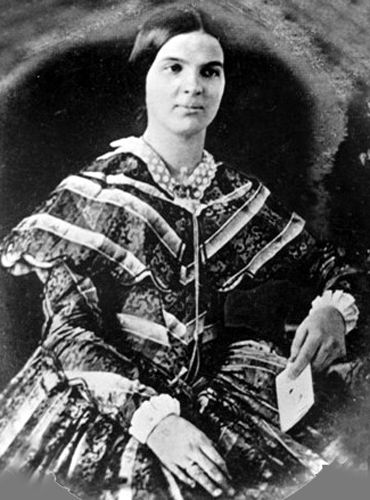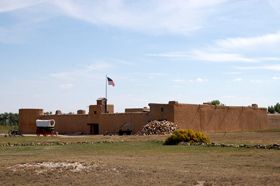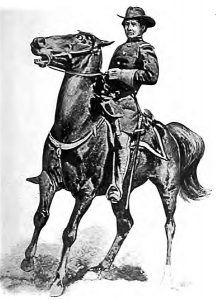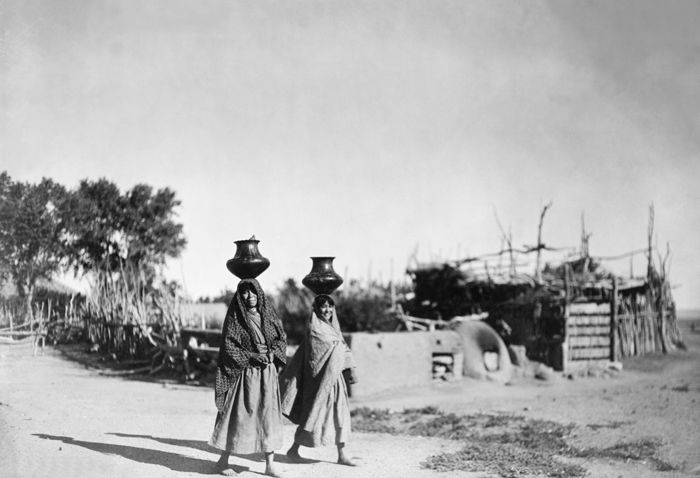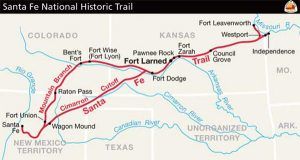Susan Shelby Magoffin was one of the first women to travel the Santa Fe Trail. Making the journey with her husband, a trader, she kept a detailed diary of her travels which has been extensively used as a source for the history of the time. She was only 18 when she first traveled the Santa Fe Trail in 1846.
Susan Shelby was born into a wealthy family on July 30, 1827, on their plantation near Danville, Kentucky. Descending from a long line of explorers and pioneers, her grandfather was Isaac Shelby, a hero of the American Revolution and the first governor of Kentucky. She grew up with servants and received a good education.
When she was 18 years old, she married Samuel Magoffin on November 25, 1845, 27 years older, and the son of an Irish immigrant who had prospered. Samuel and his brother James Wiley Magoffin had been active in the Santa Fe trade since the 1820s, traveling widely in the United States and Mexico and gaining considerable wealth. After they married, they spent their honeymoon in New York.
Instead of settling into a home, Samuel took his bride with him on his travels. On the next journey, they left Independence, Missouri, on June 10, 1846, with an outfit that included 14 large wagons with six yokes of oxen each, a baggage wagon with two yokes, a dearborn wagon with two mules that carried her maid, their own carriage with two more mules, and two men on mules driving the loose stock. Not only did they bring their maid, Jane, but they also brought her dog, a cook, and a coop of live chickens. When setting up camp at night, she stayed in a carpeted tent with a bed, mattress, table, and chairs.
Magoffin immediately began her thorough journal as she and her husband departed from Independence, Missouri. Throughout the expedition, she wrote in it almost every day, keeping a careful record of plants, animals, terrain, and people she met as she crossed the vast prairie.
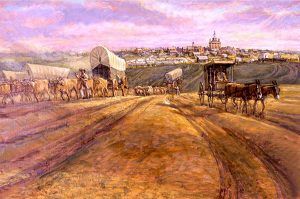
Trails Leaving Independence by Charles Goslin mural hangs in the National Trails Museum in Independence, Missouri.
With the war just beginning between the United States and Mexico, it was a perilous time to travel the trail. However, according to Magoffin’s journal, she was excited about the trip, and early entries often reflect her exuberance.
“… It is the life of a wandering princess, mine. When I do not wish to get out [of the carriage] myself to pick flowers, the Mexican servants riding on mules pick them for me…”
The journey took the Magoffins across the prairies of Kansas, where she observed many migrating buffalo.
“Such soup as we have made of the hump ribs, one of the most choice parts of the buffalo. I never eat its equal in the best hotels of N.Y. and Philada. And the sweetest butter and most delicate oil I ever tasted tis not surpassed by the marrow taken from the thigh bones.”
However, the novelty soon wore off, and on July 13, she recorded:
“Passed a great many buffalo (some thousands); they crossed our road frequently within two or three hundred yards. They are very ugly, ill-shapen things with their long shaggy hair over their heads and the great hump on their backs, and they look so droll running.”
When the group reached Bent’s Fort, Colorado, on July 27, she took to bed in the spacious private rooms they had reserved. The “Army of the West” was at the fort when the Magoffins arrived, ready to launch their invasion south into New Mexico during the Mexican-American War.
On July 31, 1846, Susan Magoffin suffered a miscarriage just after her nineteenth birthday, delaying their journey.
Leaving Bent’s Fort on August 14, 1846, they reached the Mexican settlement at Mora Creek, New Mexico, on August 25, where Susan was shocked at the primitive housing. They then made their way to Las Vegas, New Mexico. There, she sampled green chili stew, which she disliked and noted in her journal,
“I could not eat a dish so strong and unaccustomed to my palate.”
Continuing south, the Magoffins reached Santa Fe on August 31, 1846. General Stephen W. Kearny’s army entered Santa Fe on August 15, 1846, without opposition because the Mexican governor Manuel Armijo had told his soldiers not to fight. Susan’s brother-in-law James Magoffin, who had been sent to negotiate with Armijo by Kearny, may have bribed Armijo to prevent resistance.
Susan had trouble adjusting because she could not speak Spanish, and life was very different from what she had known. However, she learned some Spanish quickly, loved her adobe home, made friends, and became part of the “high society,” mingling with wealthy traders, army officers, and the elite of the Hispanic society.
However, she was astonished at women’s clothing. In her world, proper ladies wore skirts covering their ankles and blouses buttoned to the neck. However, the Mexican women wore skirts showing their calves and low-cut blouses.
She described Doña Gertrudes Barcelo, a prominent saloon owner, and professional gambler, as “the principal monte-bank keeper in Santa Fe, a stately dame of a certain age, the possessor of a portion of that shrewd sense and fascinating manner necessary to allure the wayward, inexperienced youth to the hall of final ruin.”
On October 7, 1846, the Magoffins left Santa Fe for Mexico, traveling on the El Camino Real de Tierra Adentro.
Along the way, they encountered Pueblo Indians, the prominent farming people of New Mexico. They spent some time at San Gabriel, where Susan fell ill for a while with a fever. A lady there taught her to make tortillas, which she found to take much more work than expected, and also showed her knitting techniques. Leaving there towards the end of January 1847, they traveled south through the Jornada del Muerto to Doña Ana. The Taos rebellion had broken out, so they feared attack by Mexicans in addition to the danger of the desert crossing.
On February 17, 1847, they lodged at the house of the priest Ramón Ortiz y Miera in at El Paso del Norte, a spacious house surrounded by orchards and vineyards. A fierce nationalist, Father Ortiz had been taken prisoner by Colonel Doniphan for encouraging armed resistance to the U.S. army. However, he was known for his hospitality to visitors. Susan was struck by the civilized atmosphere of the house and particularly taken with a little girl who “...only six years of age, carries with her the dignity of our girls of eighteen. It attracted my attention, particularly the evening I came; with the same ease of a lady much accustomed to society, she entered the room, with a polite bow and ‘Bonus tardes,’ shook hands with me, and seated herself.”
The Magoffins continued south in the wake of Colonel Doniphan’s army. Along the way, her health began to suffer from the journey’s hardships. On September 8, 1847, Magoffin made the last entry in her journal. She later suffered an attack of yellow fever in Matamoros, Chihuahua, Mexico. While ill, she gave birth to a son who did not survive.
In 1848 the couple left Mexico on a vessel to New Orleans, Louisiana, and then went north to live in Lexington, Kentucky. They had a daughter in 1851, and the following year, they moved to Barrett’s Station, near Kirkwood, Missouri, where Samuel bought a large estate.
Though her health had been irreparably damaged by the hardships of the Santa Fe expedition, a second daughter was born in 1855. Soon afterward, she died on October 26, 1855. She was just 28 years old. She was buried in St. Louis, Missouri.
Her journal remains a valuable record of the development of the West. Unlike many male accounts, she notes domestic issues and offers insight into women’s lives during the expansion period. Her journal also gives a detailed account of the war in Mexico and offers insight into how it affected traders like her husband.
“Oh, this is a life I would not exchange for a good deal? There is such independence, so much free uncontaminated air, which impregnates the mind, the feelings, nay every thought, with purity. I breathe free without that oppression and uneasiness felt in the gossiping groups of a settled home.”
© Kathy Alexander/Legends of America, updated November 2022.
Also See:
Santa Fe Trail – Highway to the Southwest
Sources:

